How the Timbisha Shoshone Got Their Land Back

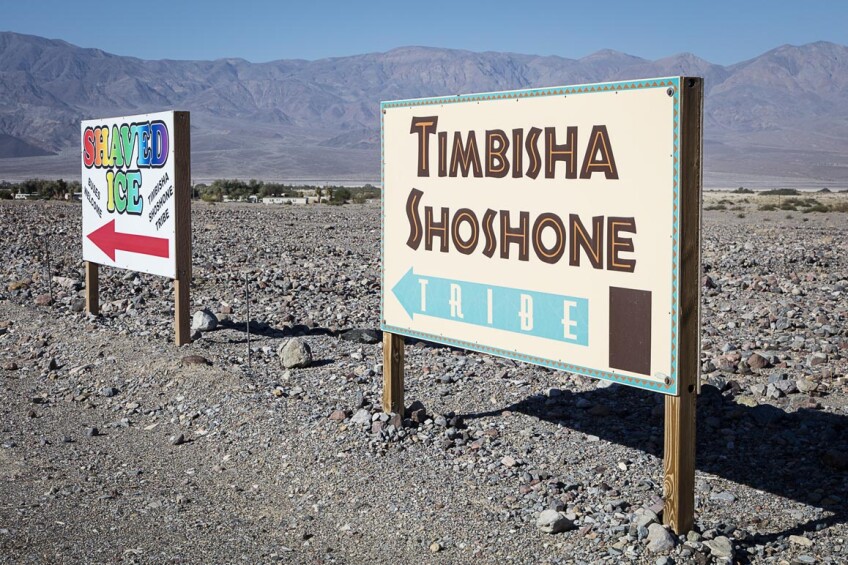
The Mojave Project is an experimental transmedia documentary by Kim Stringfellow exploring the physical, geological and cultural landscape of the Mojave Desert. The Mojave Project reconsiders and establishes multiple ways in which to interpret this unique and complex landscape, through association and connection of seemingly unrelated sites, themes, and subjects thus creating a speculative and immersive experience for its audience.
"In our religion we don’t practice within four walls. Our religion is written in all these mountains and in the valleys, in the waters, in the wildlife -- everything that belongs to the Creator. So, we’re in church everyday. That’s what we say."
-- Pauline Esteves, 92, Timbisha Shoshone elder, November 2015
It is no secret that many Native Americans were displaced and in some cases removed outright from ancestral lands during the founding of some of America’s most prized national parks. Death Valley National Park is no exception. When President Herbert Hoover established, through executive order, two million acres of Death Valley and the surrounding region as Death Valley National Monument (DVNM) on February 11, 1933, it was done so under the presumption that this “uninhabited” wilderness had no permanent residents.
Scattered prospecting and mining activities had occurred within the proposed monument boundaries during the mid to late 19th century onward, but only Pacific Coast Borax Company managed to have any lasting commercial presence here. After relocating their borate operations to more economically productive areas elsewhere in the Mojave Desert, company brass successfully lobbied the federal government to create the monument -- which conveniently supported their foray into the hospitality tourism business while making use of the existing but now obsolete borax shipping rail line. Instead of hauling borax, the trains would convey adventuresome tourists into Death Valley to stay at their swank, newly constructed Furnace Creek Inn, built in 1927. Outside of this development, along with the nearby Harmony Borax Works and a handful of other private inholdings and mining claims, Death Valley was considered “vacant” and thus ideal for national monument status. This determination discounted the fact that an aboriginal people -- the Timbisha Shoshone -- did indeed occupy this valley, especially the area at Furnace Creek and had done so for an eternity.1
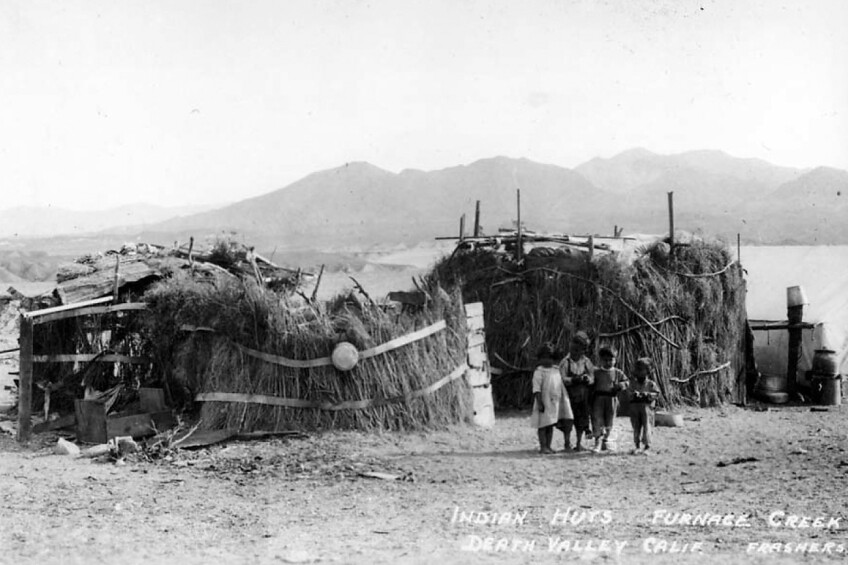
Tümpisa (timbisha) is the Shoshone name of red-ochre earth sourced by the Old Ones from the Black Hills overlooking the popular Furnace Creek recreational area. This medicinal material is smudged onto faces and used in homes to “strengthen their spirituality.” At times tümpisa was provided to other Shoshone bands that traveled to the valley in order to obtain it because of its “powerful healing properties.”2 The Timbisha have in fact resided in Death Valley -- a contemporary place name that many Timbisha loathe -- for thousands of years. Vast physical artifacts affirming their occupation can be found throughout its borders, including the often overlooked Grinding Rock at the Furnace Creek Inn’s lower parking lot with foot deep holes on its surface that were created from the continuous grinding of mesquite beans into flour over time.
The decision by the federal government in the 1930s to exclude the Timbisha from the monument was a conscious one. After all, the Timbisha had no treaty rights because they were not officially recognized as a tribal entity with no sovereign land base to call home, rendering any bargaining power that the Timbisha may have had as nil. Rather than admit that the Timbisha had a long and enduring presence here, federal officials simply chose to “pretend” that the Indians did not exist in Death Valley to allow the proposed national monument to proceed as planned.

Tüpippüh is the Timbisha name for their ancestral homeland. Tüpippüh encompasses the valley floor, playas, dunes, springs, meadows and mountains -- every landform and ecology within the borders of today’s national park and the surrounding region. Although anthropologists believe that their Uto-Aztecan ancestors migrated into the region more than one thousand years ago, the Timbisha state that they have been here from time immemorial.
Both Timbisha oral traditions and archeological findings recognize that traditional Timbisha people moved seasonally between semi-permanent villages throughout greater Death Valley. At these encampments they made use or harvested a variety of plant and animal resources when seasonally available. Winter villages were located in four different areas within Death Valley proper, but also within the Panamint and Saline Valleys plus other locations. In the current vicinity of Furnace Creek, families lived in conical brush houses among three to ten related family groups near native mesquite groves that are still present in the valley. This location was ideal as meticulously managed groves provided ample cover for small game to be tracked and hunted plus the mesquite’s beans provided an important winter food source.
As the valley floor became unbearably hot during the summer months, family groups traveled to cooler mountainous elevations and camps at Wildrose Canyon where piñon nuts, seeds, roots and berries were communally harvested. There they hunted a variety of game including bighorn sheep, mule deer, yellow-bellied marmot and black-tailed jackrabbit.3 Normally about 50 people gathered together at these summer camps. During particularly plentiful annual harvests, more than 100 individuals could be present. The summer communes also served an important social function where relatives could reacquaint themselves or where marriages were arranged. All hunting, food gathering and travel to seasonal camps were banned after the founding of the monument, with the exception of a few special-use permits to collect pine nuts and some other native foods within its boundaries.
By 1933, plenty of hard evidence supported the existence of semi-permanent Timbisha Shoshone encampments within Death Valley and monument administrators were certainly aware of this. Just a few months after the DVNM was established, newly appointed superintendent John R. White -- who was concurrently heading Sequoia National Park -- stated on an October 1933 radio broadcast that “one of the problems there will be looking after the hundred or two Indians who range within the monument.”4 White’s indifferent response subtly reflects the cornerstone of contemporary wildlands conservancy first spelled out in the groundbreaking 1964 Wilderness Act, stating that wilderness is a place where “man himself is a visitor who does not remain” and precludes aboriginal people from these same places even if their ancestral tenure goes back thousands of years.5 In White’s and his colleagues’ view, the Timbisha simply did not belong here any longer. Thus began the conscious effort by federal officials during the mid-20th century to attempt to sever the Timbisha’s deep attachment to this landscape.
Historically, only one federally recognized Native claim existed within the monument prior to its founding, belonging to the relatives of Hungry Bill -- a Timbisha Shoshone who filed acreage in Johnson Canyon in 1907 but failed to receive his patent upon death in 1919. Bill’s heirs persisted and managed to secure the 160-acre allotment by the late 1920s.6 By 1936, complications arose when another Timbisha named Robert Thompson filed a claim at Warm Springs, and like the case of Bill, the land was located on the eastern slope of the Panamint Range. The Bureau of Indian Affairs (BIA) supported this effort in order to protect land Thompson’s family had farmed since the 1880s, from a group of determined miners that were leasing the property at the time, and had contested Thompson’s right to ownership in order to take control of it for their mining operation.
Reacting to the Thompson case, White commented, “I do not believe that these Indians should be allowed to patent the springs which are of the greatest importance for public use and for monument development.” Thompson did receive his patent but no other Timbisha man (or woman) would do so afterwards. By the 1950s, the combined 200 acres of Bill’s and Thompson's allotments had been sold back to the federal government with BIA support.7
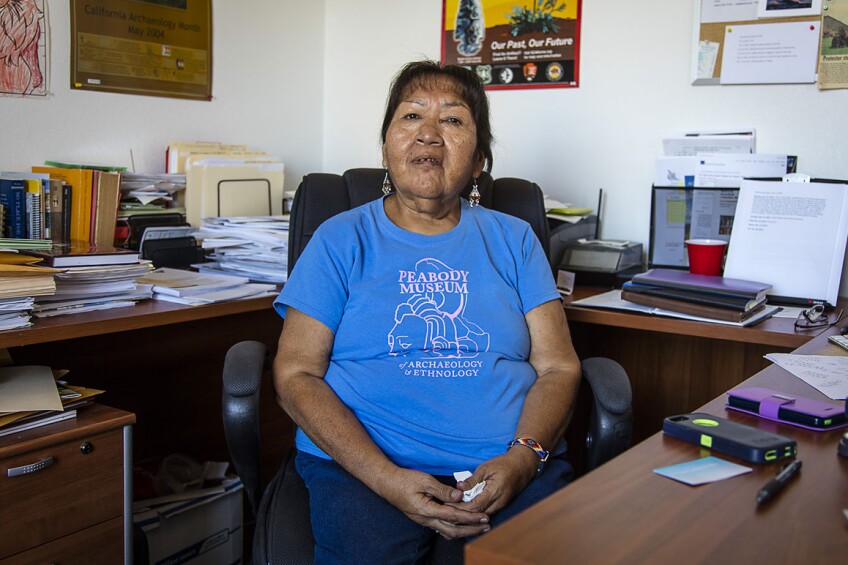
It is interesting to note that several early 20th century newspaper articles shared the popular account of “Panamint George” Hansen, a Timbisha Shoshone born in Death Valley in 1841, who as a young boy witnessed the forlorn Jayhawker ’49er party struggling across a desiccated playa near Furnace Creek, close to where his family’s winter village was located.8 Growing up, I was led to believe that the ’49ers existed in some kind of cultural vacuum -- as if they were the first humans to gaze upon what they consequently regarded, because of their adverse experience. My middle school history lesson did not include the memoir of a ’49er corroborating Hansen’s account describing a “big Indian camp” in the vicinity of Furnace Creek.9 I wonder what went through his mind as he watched the Jayhawkers in bewilderment when they burned their wagons and slaughtered their oxen, as their gold-driven lust turned into a survival of the fittest nightmare.
Other early records documented area Native settlements including a 1891 report of government expedition, stating that “Panamint” Indians (the name given to the Timbisha at the time) had been long cultivating “acres of corn, potatoes, squashes and melons in the southern end of the Death Valley,” confirming public record of Timbisha occupation within the valley prior to 1900.10
White’s previous comment clearly references the 1916 National Park Service Organic Act mandate promoting public use of the country’s national park resources in a manner that would “leave them unimpaired for the enjoyment of future generations.” He and other agency officials were additionally concerned that the Timbisha would require federal assistance down the line -- an issue that the agency was not prepared to address or fiscally take on. Visiting tourists naively described the Timbisha as “destitute” in their “squalid” village adjacent to Furnace Creek that made matters only worse for monument officials. However, some humanitarian-minded individuals in the NPS and the BIA came together to lay groundwork to “improve” the lives of the resident Timbisha through an official memorandum agreement, “Establishing a Colony of Indians on the Death Valley National Monument,” signed on May 23, 1936.
The first improvement was the relocation of the Indians to an out-of-view 40-acre sandy tract. With $5,000 provided by the BIA, a collection of 11 discrete adobe houses were built in 1938. None of these structures had electricity, running water, indoor plumbing, heating or cooling.11 A fee of $3 was established for maintenance but never collected by NPS rangers, so repairs were never completed over the years that they stood in the location. Employment within the monument was not offered to Timbisha men, so many left the area in order to find work to support their families. A laundry and trading post where Timbisha women would be on display creating and marketing native crafts were the only economic opportunities that the NPS provided and these endeavors were short lived.12
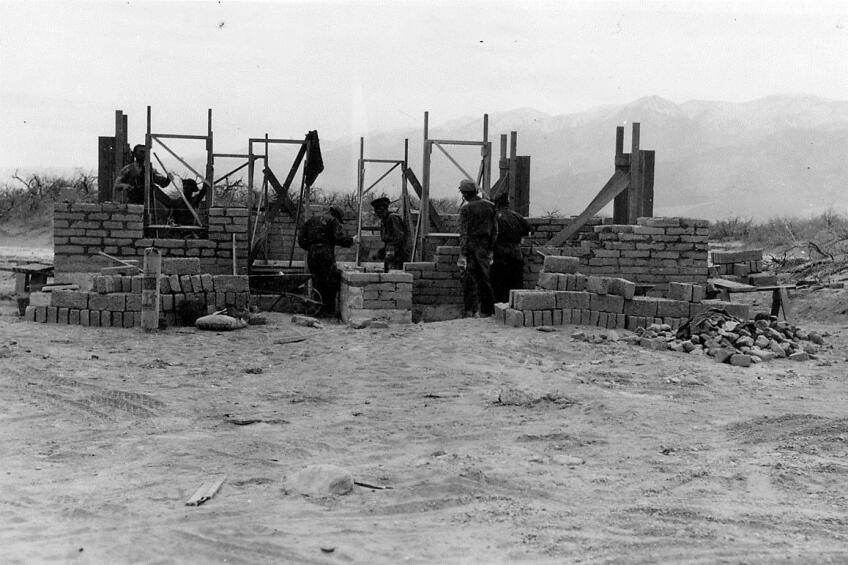
The BIA had initially funded the project in an effort to create a Timbisha land holding that would eventually transfer into Indian trust territory, allowing the Timbisha to gain recognition under the Indian Reorganization Act of 1934. But the BIA's attempt was shortsighted in that only an act of congress could transfer public land out of a national monument. This failed effort left the Timbisha without a sovereign homeland. The federal government continued to view them as “ward” Indians who could not obtain official standing without land. So the Timbisha became viewed as “squatters” in their own ancestral home well into the later part of the 20th century.
By the mid-1950s, Furnace Creek’s Indian Village was in a deplorable state. Several of the adobes were now crumbling down even though families continued to occupy them. Rather than repairing them, the NPS (who was actively eliminating NPS inholdings wherever possible) -- with approval of the BIA (who was under pressure from congress at the time to “get out of the Indian business”) decided to consciously eliminate the community through a planned administrative policy that annulled the previous 1936 memorandum of understanding.
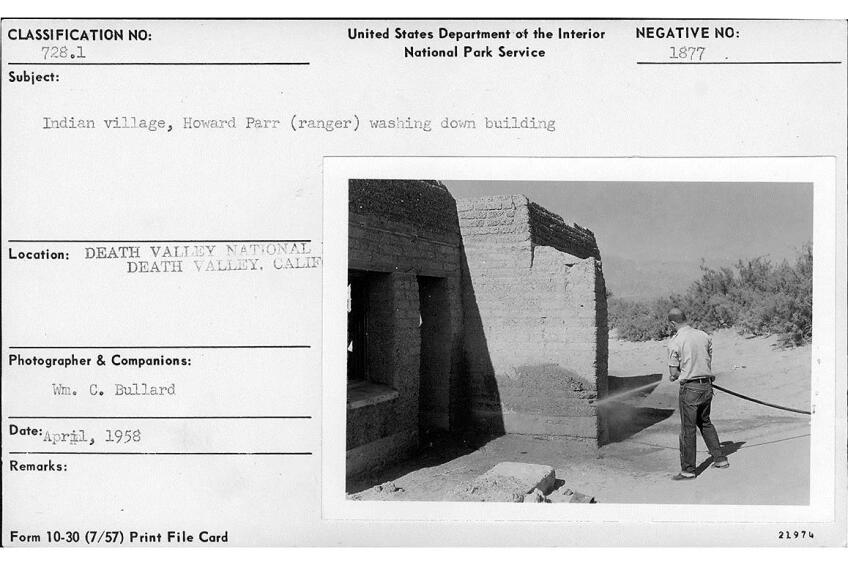
Referred to as the Death Valley Village Indian Housing Policy, this program (adopted in 1957) gave implicit permission for NPS officials to destroy homes that appeared abandoned and also forbade repairs without NPS approval. The policy was particularly cruel in that the NPS administration was well aware that the Timbisha undertook annual trips to the high country during the extreme summer months just as their ancestors had done ages before them. Homes left temporarily would be targeted for destruction.
Incoming DVNM superintendent Fred W. Binnewies ordered five of the “unoccupied” partially collapsed structures to be hosed down with water, which dissolved them due to their earthen composition.13
This act completely demoralized Timbisha onlookers, including Pauline Esteves, 92, who was in her early 30s at the time. As a child Esteves had witnessed three forced relocations of her people’s village to increasingly less desirable locations in the vicinity of Furnace Creek. Out of fear of having all of the homes destroyed -- most likely leading to their forced eviction -- Esteves’ mother Rosie and four of her sisters collectively refused to pay the special-use permit fee and remained within their homes in defiance of the NPS’s official removal policy. Some years later monument officials halted their plans for eviction, anticipating that the remaining village occupants would abandon it once the women passed away.14 Monument officials were foolishly unaware that younger, insuppressible Timbisha would take their place.
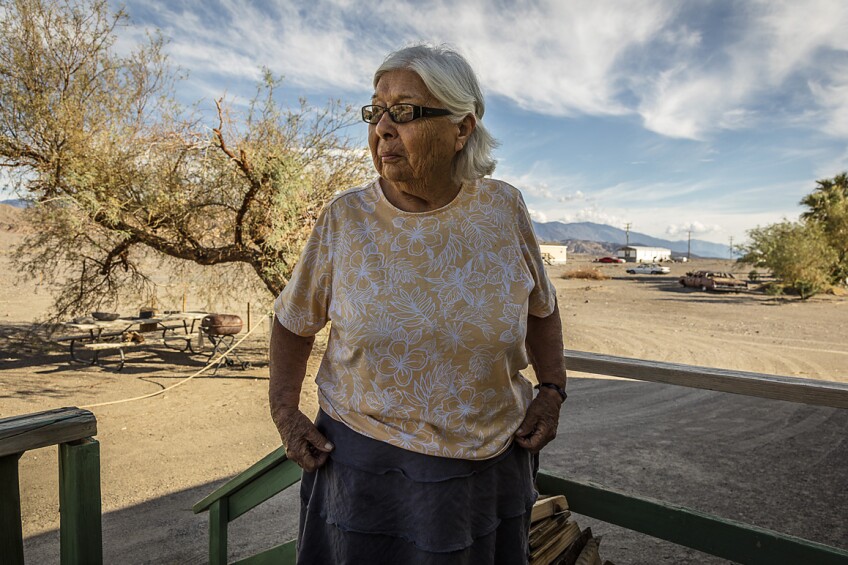
After years of persistent activism by Esteves and many others -- along with the assistance of the California Indian Legal Services -- the Timbisha Shoshone received federal tribal recognition as a sovereign entity in 1983. However, they continued to be landless and this status remained the community’s priority issue into the 1990s when it escalated into a crisis.
To provide a context, congress supported a provisional study for trust lands suitable for the Timbisha inside the monument that were included in the California Desert Protection Act (CDPA), signed into law by President Clinton on October 31, 1994. The act also renamed the monument as Death Valley National Park (DVNP), increasing its holdings by another 1.3-million acres.
The process to identify trust lands after the signing of CDPA took a contentious turn between the tribal members and their representatives, the NPS and the Department of the Interior after negotiations failed. Impatient with the unproductive dialogue between parties, Timbisha Shoshone representatives struck up a partnership with the Alliance to Protect Native Rights in National Parks and organized around 75 protestors including several Timbisha elders along with Indians from neighboring tribes and representatives from four environmental groups like Greenpeace. The group assembled in the early morning on Memorial Day 1996 near the village entrance at State Route 190, carrying placards stating, "This is our homeland" and "Cultural respect, not cultural genocide."15 The group walked in solidarity a half-mile towards the Furnace Creek visitor center in near sweltering heat aided by water cooling stations along the route. Their presence stopped passersby traveling along the SR-190 who became curious about all of the commotion that had sparked international news coverage.
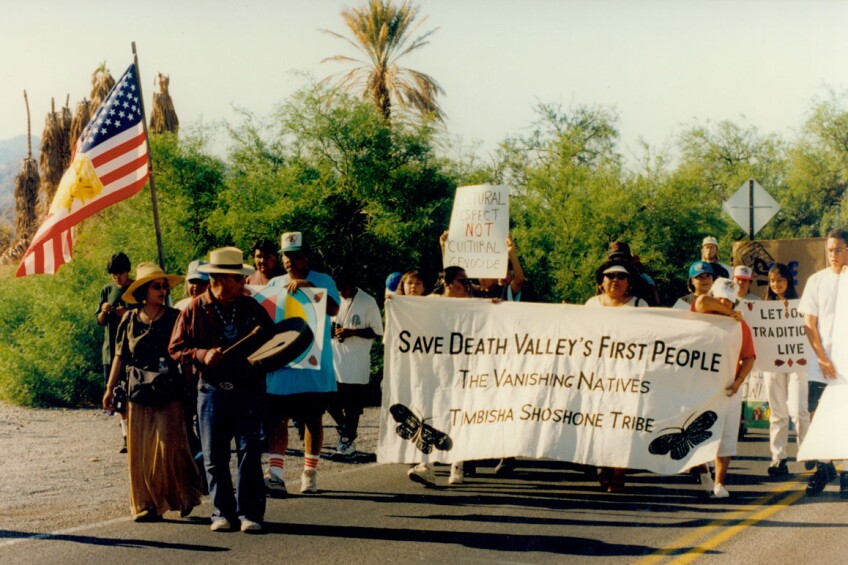
Considered a success, the protest, in part, brought about restructured and more inclusive “government-to-government” dialogue between all parties involved. This led to the eventual signing of the Timbisha Shoshone Homeland Act by President Clinton in 2000 which brought a global spotlight to the tribe’s 65-year struggle to secure a permanent land base within their ancestral home. The act transferred 7,753.99 acres to the tribe, including 313.99 acres at Furnace Creek with the remaining acreage as noncontiguous parcels outside DVNP. It additionally specified “designated special-use areas in which tribal members are authorized to pursue low-impact, ecologically sustainable, traditional practices under a management plan mutually agreed upon by the Tribe and the NPS.”16
The act does allow modest commercial development, including a visitor center and gift shop, plus a “small-to-moderate” desert inn, but prohibits any future Indian gaming within trust lands inside park boundaries.17 Special-use areas include seasonal camps at Wildrose Peak and Hunter Mountain, plus a “mesquite use area” near the Furnace Creek village allows tribal members to continue traditional mesquite-harvesting practices within DVNP under a cooperative management plan between the tribe and the NPS. Shortly after the act was passed, the acting park superintendent had the subheading, “Homeland of the Timbisha Shoshone,” added to the park’s entry signage -- a modest, but extremely important gesture for the tribe.
This far-reaching policy shift allowing the Timbisha Shoshone to exist permanently within one of the nation’s national parks sets a precedent affirming Native peoples' land rights within shared public grounds and confirms their legitimate and continued role as managers and stewards of our most valued wild spaces.
Today 35 to 40 Timbisha Shoshone live year-round at the homeland within DVNP, although their tribal membership numbers 400 regionally. Contemporary Timbisha will continue to face uphill challenges: strife among their tribal membership, and a shortage of younger tribal members willing to learn and implement traditional practices. Although the Timbisha have shown their persistence and resilience in one of the planet’s most harsh environments, climate change will additionally affect their ability to thrive within their ancestral homeland well into the future.
This Mojave Project dispatch was authored under the consultation of Timbisha tribal elders Pauline Esteves and Barbara Durham.
Notes:
1 The Timbisha Shoshone were one of the few groups of western Indians to have “escaped the clutches of reservation life” in the early 20th century.
2 Esteves, Pauline. "Preface to the Draft Secretarial Report to Congress." April 1999. Interview with Pauline and author October 20, 2015 at Timbisha Village, Death Valley, CA.
3 Catton, Theodore. "To Make a Better Nation: An Administrative History of the Timbisha Homeland Act." Report prepared under cooperative agreement with Rocky Mountain Cooperative Ecosystem Studies Unit for Death Valley National Park. October 2009.19.
4 Catton. 23.
5 For further reading see: Cronon, William. “The Trouble with Wilderness; or Getting Back to the Wrong Nature." Uncommon Ground: Rethinking the Human Place in Nature. New York: W.W. Norton & Co. 1995. 69-90.
6 Catton. 23.
7 Catton. 30.
8 Crum, Steven J. “Pretending They Didn’t Exist: The Timbisha Shoshone Tribe of Death Valley, California and Death Valley National Monument.” Southern California Quarterly Vol. 84, No. 3/4 (Fall/Winter 2002): 225.
9 Catton. 20.
10 Catton. 21. The author suspects that this is a reference to either Hungry Bill’s or Robert Thompson’s allotment as they were both known to be farming in this same area.
11 Timbisha Village did not receive electricity until the mid to late 1970s. Catton. 33.
12 Catton. 29.
13 Catton. 29.
14 Catton. 30.
15 Catton. 5.
16 Bill Text 106th Congress (1999-2000) S.2102.ENR. Section 4. Definitions. (a).
17 Barbara Durham (personal communication with the author, June 23, 2016): “A faction of the Tribe chose to move our administrative office to Bishop. The Tribal Council is proposing a Timbisha Shoshone casino outside our sovereign land bases in Ridgecrest, California.”
Dig this story? Sign up for our newsletter to get unique arts & culture stories and videos from across Southern California in your inbox. Also, follow Artbound on Facebook, Twitter, and Youtube.